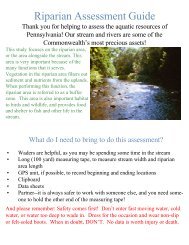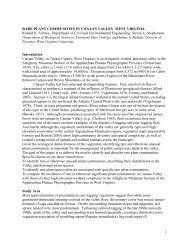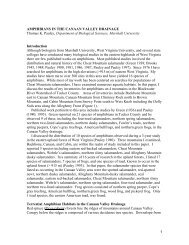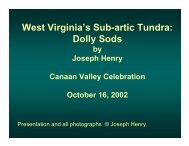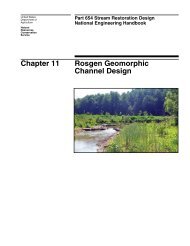FISHES OF THE BLACKWATER RIVER DRAINAGE, TUCKER ...
FISHES OF THE BLACKWATER RIVER DRAINAGE, TUCKER ...
FISHES OF THE BLACKWATER RIVER DRAINAGE, TUCKER ...
You also want an ePaper? Increase the reach of your titles
YUMPU automatically turns print PDFs into web optimized ePapers that Google loves.
<strong>FISHES</strong> <strong>OF</strong> <strong>THE</strong> <strong>BLACKWATER</strong> <strong>RIVER</strong> <strong>DRAINAGE</strong>, <strong>TUCKER</strong> COUNTY,WEST VIRGINIAD.A. Cincotta, D. P. Wegman, and T. E. Oldham, West Virginia Division of NaturalResources, Wildlife Resources Section; and S.A. Welsh and L.B. Hedrick, USGeological Survey, West Virginia University Cooperative Fish and Wildlife ResearchUnit
IntroductionThe fish fauna of the Monongahela River basin (105 species, including 14 introductions)was assembled from pre-Pleistocene communities, drainage changes during thePleistocene, subsequent invasions from the south that emanated from the ancient TeaysRiver, and recent introductions (Lee et al. 1980, Hendricks et al. 1983, Hocutt et al. 1986,Stauffer et al. 1995). The Monongahela River was once part of the prehistoric PittsburghRiver drainage or a major tributary of the present day St. Lawrence River system thatflowed north and then east to the Atlantic Ocean (Hocutt et al. 1986). The ancientprecursor to the Monongahela and Allegheny rivers, the Old Lower Allegheny River, aPittsburgh River tributary, drained northern West Virginia, western Maryland, westernPennsylvania, and eastern Ohio. During Pleistocene glaciation, north flowing waters weredammed by the Illinoian ice sheet to form Lake Monongahela in the north, andimmediately to the south of this basin, the adjoining Teays River drainage’s westernflowing waters were cut off to create Lake Teays (Hocutt et al. 1986). LakeMonongahela rose to 305 m (1001 ft) above sea level and overflowed into the OldMiddle Island Creek, and the Little Kanawha and Marietta rivers of the prehistoric TeaysRiver (Hocutt et al. 1986). At times, Lake Teays probably had waters that overflowedinto the Old Lower Allegheny watershed also. During and after glacial retreat, theresultant deposits, redirected channels, stream captures, and lake overflows created theupper Ohio River drainage as we know it today.Hocutt et al. (1986) recognized redside dace, rosefin shiner (Lythrurusumbratilus), bigmouth shiner (Notropis dorsalis), and longnose sucker (Catostomuscatostomus) in the Monongahela River drainage as glacial relics. Additionally, we regardpearl dace (Margariscus margarita) as a glacial relic.Most of these species were extirpated from the upper Monongahela Riverdrainage, West Virginia, except redside dace and pearl dace. This paper summarizeshistoric and current fish collections of the lower and upper Blackwater River, a tributaryof the upper Monongahela River.Study AreaThe Blackwater River, 52.1 km (32.4 mi) long, with a drainage area of 36,176 ha (89,393sq mi), originates on the southeast face of Canaan Mountain, eastern Tucker County,West Virginia, at an elevation near 1189 m (3900 ft). At 975m (3200 ft), the river turnsnortheast and drains the southern end of Canaan Valley (Fig 1). Major tributaries withinsouthern Canaan Valley are from headwaters of the western-draining Cabin Mountain ofthe Allegheny Front, which peaks at about 1310 m (4300 ft). In northern Canaan Valley,the river makes an abrupt swing to the northwest and cuts through Canaan/BrownMountain at 951 m (3120 ft). At 914 m (3000 ft), immediately below the town of Davis,it drops 18.3 m (60 ft) over Blackwater Falls and proceeds 15.4 km (9.6 mi) through adeep gorge to its confluence with Dry Fork River at Hendricks; this junction formsBlackfork River, which flows 7.0 km (4.4 mi) and merges (at Parsons) with the ShaversFork to form the main channel of Cheat River.Review of Fish CollectionsTo summarize data (in approximately 10 year increments) on fish distributions in theBlackwater River drainage from 1899 to the present (Tables 1, 2; Fig. 1), we reviewedpublished and grey literature, museum specimens (U.S. National Museum, CornellUniversity, The Pennsylvania State University), and unpublished state stocking reports ofthe West Virginia Division of Natural Resources (WVDNR). Unpublished documentsand raw data cited herein are available at Canaan Valley Institute’s Library, Thomas,West Virginia.
In 1899, the U. S. Bureau of Fisheries commissioned W.P. Hay, head of theDepartment of Biology in Washington D.C. high schools, to survey fishes in WestVirginia. These collections evaluated complaints of poor fishing, especially in areas witha “ . . . former reputation for abundance of fishes . . .” , but were now thought to bedeclining (Goldsbourgh and Clark 1908). In northeast portions of the state, Mr. Haysampled headwaters of the Monongahela, Potomac, and Greenbrier rivers. In CanaanValley, he collected at one site on the North Branch, recording only brook trout(Salvelinus fontinalis). Based on this statewide survey, Goldsbourgh and Clark (1908)reported “. . . that aquatic life in general, and fishes in particular, had been and are now inmany streams being greatly injured and in others practically destroyed by the unwise anddestructive operations of the lumberman and the miner.”Other fish collections were not made in the Blackwater River until the 1940s.Under the direction of E. Seaman, a fisheries biologist at the WV ConservationCommission (presently the WVDNR; see Cincotta et al. 1986a), two collections weremade in the drainage in 1946 as part of an effort to document the fishes of West Virginia.Seven species were collected: redside dace, silverjaw minnow (Ericymba buccata),bluntnose minnow (Pimephales notatus), eastern blacknose dace (Rhinichthys atratulus),creek chub (Semotilus atromaculatus), white sucker (Catostomus commersoni), andbrook trout.In 1956, Dr. F. J. Schwartz of West Virginia University collected 10 species in theBlackwater River during 15 seine surveys, adding black bullhead (Ameiurus melas),brown trout (Salmo trutta), mottled sculpin (Cottus bairdi), and rock bass (Ambloplitesrupestris) to the faunal list (Schwartz, in Core et al. 1959). Schwartz did not capturefishes at three stations, apparently due to acid mine drainage. Later in the 1950s, D.Gasper of the WV Conservation Commission (WVDNR unpubl. data) captured 14 fishesduring two electrofishing surveys in Canaan Valley, including first records of centralstoneroller (Campostoma anomalum), river chub (Nocomis micropogon), longnose dace(Rhinichthys cataractae), northern hogsucker (Hypentelium nigricans), green sunfish(Lepomis cyanellus), greenside darter (Etheostoma blennioides), johnny darter(Etheostoma nigrum), and blackside darter (Percina maculata).During the 1960s, D. Gasper and B. Pierce (WVDNR unpubl. data) collected 14species during six rotenone surveys, and added stonecat (Noturus flavus) and fantaildarter (Etheostoma flabellare) to the list.In 1978, six seine collections by Drs. R. F. Denoncourt, C.H. Hocutt, and J. R.Stauffer captured 19 fishes, four of which represented additions to the Blackwater Riverspecies list (Hocutt et al. 1981, Stauffer et al. 1995). These surveys reported the first loticrecords of fathead minnow (Pimephales promelas), brown bullhead (Ameiurusnebulosus), largemouth bass (Micropterus salmoides), and bluegill (Lepomismacrochirus) in the drainage. Ten surveys made between 1978 and 1987 by D. Pharesand T. E. Oldham (WVDNR unpubl. data) also produced 19 species, adding goldenshiner (Notemigonus crysoleucas) and pumpkinseed sunfish (Lepomis gibossus) to thetally.An acid neutralization station, constructed in 1994 near Davis, reduced impacts ofacid mine drainage on the Blackwater River (WVDNR 2000, Zurbuch 2002b). Nine preandpost-treatment surveys (conducted by WVDNR with rotenone and/or electrofishinggear) yielded 21 species (WVDNR 2000). Of these fishes, sand shiner (Notropisstramineus), yellow bullhead (Ameiurus natalis), and margined madtom (Noturusinsignis) were taken for the first time in the watershed.Dr. M. Gatch of the University of19
Michigan surveyed northern West Virginia in the 1990’s to evaluate redside dacepopulations (Gatch unpubl. data). She made two collections in Sand Run and observed15 fishes, all of which were recorded previously.After 2000, one of the authors (D.A.Cincotta; WVDNR unpubl. data) surveyedFreeland and Sand runs for a redside dace genetic study (Bowen et al. 2000), but norecords were new to the watershed. Additionally, he completed an electrofishing samplein 2002 of the main channel Blackwater River near its mouth to confirm reestablishmentof fishes after acid remediation projects. This effort yielded fifteen species, whichincluded the following seven additions to the drainage checklist: spotfin shiner(Cyprinella spiloptera), striped shiner (Luxilus chrysocephalus), silver shiner (Notropisphotogenis), rosyface shiner (N. rubellus), smallmouth bass (Micropterus dolomieu),bluebreast darter (Etheostoma camurum), and variegate darter (E. variatum). Othersurveys during this period were conducted in Canaan Valley by the WVDNR (T. E.Oldham unpubl. data) and in Beaver Creek by West Virginia University (L. B. Hedrickunpubl. data) but reported only species known from the drainage.Origin and StatusStauffer et al. (1995) reported 68 native and 8 introduced fishes in the MonongahelaRiver of West Virginia and mapped the distribution of each species. The ichthyofauna ofthe drainage represents species stocks associated with the ancient Teays and Pittsburghrivers, and the present day Ohio River (as formed by connection of tributaries of the OldMarrietta/Teays and Steubenville/Pittsburgh rivers after glacial retreat). Proglacialoverflows from Lake Teays and/or Monongahela, and stream capture sites likely explainearly invasions of fishes from the Teays to the Monongahela. Hocutt et al. (1979, 1986)hypothesized that the occurrence of the rosyside dace (Clinostomus funduloides),tonguetied minnow (Exoglossum laurae), silverjaw minnow, river chub, greenside darter,and sharpnose darter (Percina oxyrhynchus) are the result of a Greenbrier and/or OldGauley River (upper Teays tributaries) capture of the Monongahela River.Stream capture may also explain the presence of eastern blacknose dace in theMonongahela drainage. In the central Appalachian region, the eastern blacknose dace(Rhinichtys atratulus) is native and usually restricted to Atlantic slope streams, while thewestern blacknose (R. obtusus) is indigenous to streams of the Ohio River (Matthews etal.1982, Jenkins and Burkhead 1994). Even though these species are difficult to separatemorphologically and are known to hybridize when sympatric (Matthews et al. 1982), theywere recently recognized as valid species (see Nelson et al. 2004). Hubbs and Lagler(1958) regarded the eastern form’s presence in the Youghiogheny River of theMonongahela the result of a Potomac River transfer. The eastern and western blacknosedace are sympatric in the Cheat River where many Ohio/Potomac stream capture routeshave been identified (see Jenkins et al. 1972, Hocutt et al. 1986). The form present in theBlackwater River is atratulus or possibly an intergrade of both species (Little et al. 1991).For the purposes of this paper, we will call it R. atratulus or the eastern blacknose dace.The fishes of the Blackwater River are typical to the Monongahela Riverdrainage, but more specifically the Cheat River. Hocutt et al. (1986) suggestedichthyofaunal variation among major tributaries of the Monongahela drainage was due toglaciation, especially in the depauperate eastern sub-drainages. Faunal differences alsoprobably occur within the Monongahela because of acid mine drainage, the rigorousmontane habitat, and the lack of historic collections (Jenkins et al. 1972, Hocutt et al(1986). Acid mine drainage has severely affected fish populations in this region,20
particularly in the Cheat and Youghiogheny rivers (Jernejcic et al. 1978, Menendez 1978,Hendricks et al. 1983, Cincotta et. al 1986b, Welsh and Perry 1997, WVDNR 2000).Physical barriers, such as rigorous cataracts and falls, are well recognized as barriers tofish dispersal (Hocutt et al. 1986, Stauffer et al. 1995, Cincotta in Christmas et al. 1998).Below we discuss the origin (native or introduced) and status (present, absent,extirpated, or expected) of fishes from the upper and lower Blackwater River (Table 3).We define the upper area as the portion above the 19.8 meter high Blackwater Falls, andthe lower as the waters between the mouth and the falls (Fig. 1). It should be noted thatacid mine drainage has significantly influenced the fauna in both sections of the drainage.Above Blackwater FallsTwenty native species are known from the Blackwater River watershed upstream ofBlackwater Falls (Tables 2,3): central stoneroller, redside dace, silverjaw minnow, riverchub, bluntnose minnow, eastern blacknose dace, longnose dace, creek chub, whitesucker, northern hogsucker, brown bullhead, stonecat, brook trout, mottled sculpin, rockbass, green sunfish, greenside darter, fantail darter, johnny darter, and blackside darter.All were collected before1978, except brown bullhead.Several species have been introduced into the watershed. Brown and rainbowtrout have been stocked since the early 1900s (Zurbuch in review, 2002a ). Warmwaterfish stockings were apparently uncommon. Conservation Commission reports (WVDNRunpubl. data) discuss placement of “sunfish” into a Thomas pond in 1924, “catfish” inDavis and Thomas ponds in 1922 and 1924, and largemouth bass in beaver ponds in 1963and 1964. Development in the upper Blackwater River watershed (e.g., Canaan Valleygolf course and ski area, Timberline Resort) in the 1960s and 1970s coincided withadditional fish occurrences. Records of golden shiner, sand shiner, fathead minnow,yellow bullhead, largemouth bass, pumpkinseed, and bluegill are attributed to landownerand angler releases.The stonecat madtom, first collected in the Blackwater drainage in the 1960s,hybridizes with the margined madtom (Welsh and Cincotta 2004). The marginedmadtom, distributed primarily in Atlantic slope drainages (Taylor 1969), occurs in theBlackwater River and only a few other Ohio River drainages (i.e., New River, Big SandyCreek of the lower Cheat River, and the upper Tennessee River; Hocutt et al. 1986,Jenkins and Burkhead 1994). We regard the margined madtom as introduced here, butrecognize that it is possibly native to the Monongahela drainage. Its disjunct distributionand hybridization with the stonecat are consistent with biological profiles of introducedspecies.Problematic data existed among past collectors. Unverifiable black bullheadrecords were reported from the drainage by F. J. Schwartz (unpubl. data) and B. Pierce(WVDNR unpubl. data) in 1956 and 1966, respectively. Owing to the difficulty indistinguishing these fishes in the Ohio River (see Trautman 1981), and the absence ofblack bullhead specimens from the Monongahela River basin of West Virginia (Staufferet al. 1995) and Pennsylvania (Cooper 1983), we regard these records as brownbullheads. Hocutt et al.(1981) collected mottled sculpin from three Blackwater Riversites in Canaan Valley, apparently however, Stauffer et al. (1995) inadvertently omittedthese data from their book. Stauffer et. al (1995) reported the blue sucker (Cycleptuselongatus) from the upper Blackwater River; the occurrence of this large river species inthe mountains is highly suspect. Distribution maps from a manuscript of The Fishes ofWest Virginia (Stauffer et al. 1995) depicted “C. elongatus” in the upper Blackwater21
River. We speculate that this record likely represents data for the redside dace instead ofthe blue sucker, as both share the abbreviation “C. elongatus”.Our review also revealedconfusing records of data from F.J. Schwartz (in Core et al. 1959), where notations forlocality data in the Cheat and Blackwater rivers were inconsistent. F. J. Schwartz,however, provided original field data to avoid misinterpretation of data from Core et al.(1959).We were unable to detect most long-term changes to the fish fauna of theBlackwater River because extensive baseline records were lacking. Data before and after1978 were compared and indicated population declines and/or losses of six species(brook trout, redside dace, river chub, northern hogsucker, fantail darter, and blacksidedarter). The range of the resident brook trout was reduced to mainly spring fed tributaries.Redside dace were common in Canaan Valley during the 1940s and 1950s but arecurrently rare. River chub, northern hogsucker, fantail darter, and blackside darter weretaken in the upper drainage only once between 1956 and 1967; although their occurrencesmay represent misidentifications or introductions by fishermen, we regard them as nativesince all are found in nearby Monongahela River drainages. The other 16 fishes listedabove are extant and common in streams of good water quality and adequate habitatwithin the upper Blackwater drainage (Table 3).Below Blackwater FallsAcid mine drainage has severely impacted the fauna of the Blackwater River’s mainchannel from the mouth of Beaver Creek to its confluence with the Dry Fork (Fig. 1).Recent acid remediation projects have increased faunal diversity. Although we did notsubstantiate recent records of brook trout below the falls, we consider brook trout to benative in the lower drainage based on historic records (Zurbuch in review, 2002a). Fishespresently found below the falls include: central stoneroller, spotfin shiner, silverjawminnow, striped shiner, river chub, golden shiner, silver shiner, rosyface shiner,bluntnose minnow, blacknose dace, longnose dace, creek chub, white sucker, northernhogsucker, brown bullhead, stonecat, margined madtom, rainbow trout, brown trout,mottled sculpin, rock bass, smallmouth bass, largemouth bass, green sunfish, greensidedarter, bluebreast darter, johnny darter, and variegate darter (Table 3). All are native tothe lower Blackwater and Monongahela rivers, except rainbow and brown trouts, andmargined madtom.Populations of the 27 species listed above are influenced by water quality.Species of small streams, such as eastern blacknose dace, creek chub, and white sucker,are common in tributaries not degraded by mining or natural acidity. Based on recentdata, fish populations have been reestablished in the main stem Blackwater River, buttheir persistence hinges on acid remediation. The following species from nearby waters(Dry Fork, Blackfork, Shavers Fork and Cheat rivers) may be expected to occur in theBlackwater River: rosyside dace (Clinostomus funduloides), pearl dace, mimic shiner(Notropis volucellus), popeye shiner (Notropis ariommus), cheat minnow(Pararhinichthys bowersi), banded darter (Etheostoma zonale), and sharpnose darter(Percina oxyrhynchus).SummarySince 1899, biologists have conducted 67 fish surveys at 34 sites in the Blackwater Riverdrainage. Thirty-seven species have been collected: 20 native and 10 introduced fishesare known above Blackwater Falls, and 26 and 3 below the falls. We attribute the greater22
ichness in the upper watershed to sportfish and bait bucket introductions. Domesticwater use, excess siltation, and nutrient loading, impoundment construction, historiclumbering and tannery operations, and acid mine drainage have impacted the speciescomposition over time. Populations of brook trout and redside dace have been reduced.Four species (river chub, northern hogsucker, fantail darter, blackside darter) are likelyextirpated from the upper drainage. Recent acid remediation projects improved waterquality, which promoted fish re-colonization; a recent collection from the lowerBlackwater River included seven new species records for the drainage. Reestablishmentof fishes in the lower Blackwater River (from Davis to the mouth) is impressive, giventhat this section was virtually devoid of life prior to1995.AcknowledgementsWe thank all past and present WV Division of Natural Resources employees whocollected and prepared data cited herein, particularly F. Jernejcic, R. Doyle, M. Everhart,J. Cseripko, G. Weaver, and A. Johnson. Dr. F. J. Schwartz graciously provided originalfield data from 1956. Information from Dr. M. Gatch was made available to the authorsthrough the state’s wildlife database, as it was collected via a grant from the WVDNR’sWildlife Diversity Program. Special appreciation is extended to J. Harrison, who gave uselevation and stream length data, and prepared our drainage map. We are indebted to B.Sargent for retrieving much of the historic WVDNR information from the state streamdatabase and to D. Hale for typing the manuscript. West Virginia Division of Highwaysfunded recent Beaver Creek surveys. P. E. Zurbuch and B. McDonald reviewed the draft.Lastly, we dedicate this paper to Chris Clower and Jim Rawson, whose painstakingefforts to protect and manage the natural resources of Canaan Valley gave us the impetusto prepare this paper for Canaan Valley Institute’s “Celebration of the Valley.”ReferencesBowen, W.C., B.D. Faulknier, D.A. Cincotta, K.G. Barnett, and D.C. Tarter.2000. A baseline genetic study of the reside dace in West Virginia.Association of Southeastern Biologists Bulletin 47(2): 151.Christmas, J., R. Eades, D. Cincotta, A. Shiels, R. Miller, J. Siemien, T. Sinnot,and P. Fuller. 1998. History, management, and status of introduced fishesin the Chesapeake Bay region. Pages 97-116, in Therres, G.D., editor.Conservation of biological diversity: a key to restoration of Chesapeake Bayecosystem and beyond. Maryland Department of Natural Resources,Annapolis, MD.Cincotta, D.A., R. L. Miles, M. E. Hoeft, and G. E. Lewis. 1986a. Discovery ofNoturus eleutherus, Noturus stigmosus, and Percina peltata in WestVirginia, with discussions of other additions and records of fishes.Brimleyana 12: 101-121.Cincotta, D.A., K.L. Dull, S.L. Markham, and R.D. Williams. 1986b.Ichthyofaunal checklist and comparison of the two North Branch PotomacRiver tributaries where alleged Ohio-Potomac stream captures occurred.Proc. Pa. Acad. Sci. 60:129-134.Cooper, E. L. 1983. Fishes of Pennsylvania. Pennsylvania State UniversityPress, University Park. 243 pp.Core, E.L. 1959. Biological investigations of Cheat Lake. West VirginiaUniversity, Morgantown, mimeo 39 pp.23
Goldsborough, E.L. and H.W. Clark. 1908. Fishes of West Virginia. Bull. U.S.Bur.Fish. 27(1907): 29-39.Hendricks, M.L., J.R. Stauffer, Jr., and C.H. Hocutt. 1983. The zoogeography ofthe fishes of the Youghiogheny River system, Pennsylvania, Maryland andWest Virginia. Amer. Midl. Nat. 110:145-164.Hocutt, C.H. 1979. Drainage evolution and fish dispersal in the centralAppalachians. Geological Society of America Bulletin, Part II 90:197-234.Hocutt, C.H., J.R. Stauffer, Jr., T.Y. Barila, and R.F. Denoncourt. 1981. Fishes ofThe Monongahela National Forest, with a provisional key to the fishes ofWest Virginia. Report submitted to the US National Forest Service,Monongahela National Forest, Elkins, WV.Hocutt, C.H., R.E. Jenkins, and J.R. Stauffer, Jr. 1986. Zoogeography of thecentral Appalachians and central Atlantic coastal plain. Pages 161-212 inHocutt, C.H., and E.O. Wiley, editors. The zoogeography of NorthAmerican freshwater fishes. John Wiley and Sons, NY. 866 pp.Hubbs, C., and K. F. Lagler. 1958. Fishes of the Great Lakes Region.University of Michigan Press, Ann Arbor. 213pp.Jenkins, R.E., E.A. Lachner, and F.J. Schwartz. 1972. Fishes of the centralAppalachian drainages: their distribution and distribution and dispersal. VPI andState Univ. Res. Div. Monograph 4:43-117.Jenkins, R.E., and N.M. Burkhead. 1994. Freshwater fishes of Virginia.American Fisheries Society, Bethesda, MD. 1079 pp.Jernejcic, F. 1978. Effects of mining on Tygart Lake. Pages 146-159 in Samuel,D. E., J. R. Stauffer, Jr., C.E. Hocutt, and W.T. Mason, Jr., editors.Surface mining and fish/wildlife needs in the Eastern United States.FWS/OBS-78/81 December1978.Lee, D. S., C. R. Gilbert, C. H. Hocutt, R. E. Jenkins, D. E. McAllister and J. R.Stauffer,Jr. 1980. Atlas of North American Freshwater Fishes. N.C. StateMus. Nat. Hist., Raleigh. 854 pp.Little, M. L., D. C. Tarter, and M. D. Adkins. 1991. The distribution of blacknosedace in the Appalachian Highlands. Association of SoutheasternBiologists. Boone, NC.Matthews, W. T., R. E. Jenkins, and J. T. Stryron, Jr. 1982. Systematics of twoforms of blacknose dace, Rhinichthys atratulus (Pices: Cyprinidae), in azone of syntopy, with a review of the species group. Copeia 1982: 902-920.Menendez, R., 1978. Effects of acid water on Shavers Fork: a case history.Pages 160-169 in Samuel, D.E., J.R. Stauffer, Jr., C.H. Hocutt, and W.T.Mason, Jr., editors. Surface mining and fish/wildlife needs in the EasternUnited States. FWS/OBS-78/81 December 1978.Nelson, J. S., E. J. Crossman, H. Espinosa-Perez, L. T. Findley, C. R. Gilbert, R.24
N. Lea, and J. D. Williams. 2004. Common and scientific names of fishesfrom the United States, Canada, and Mexico. American Fisheries SocietySpecial Publication 29 (Sixth Edition). Bethesda, MD.Stauffer, J.R. Jr., J.M. Boltz, and L. R. White. 1995. The fishes of West Virginia.Proc. Acad. Nat. Sci., Philadelphia 146:1-389.Taylor, W.R. 1969. A revision of the catfish genus Noturus Rafinesque, with ananalysis of higher groups in the Ictaluridae. US National Museum, WashingtonD.C. (Bulletin 282). 315pp.Trautman, M.B. 1981. The fishes of Ohio. Ohio State Univ. Press. 782 pp.Welsh, S.A., and S. A. Perry. 1997. Acidification and fish occurrence in theupper Cheat River drainage, West Virginia. Journal of American WaterResources Association 33(2): 423-429.Welsh, S. A., and D. A. Cincotta. 2004. Natural hybrids of the madtoms, Noturusflavus and Noturus insignis, from the Monongahela River drainage, WestVirginia. Northeastern Naturalist 11(4):399-406.WVDNR. 2000. Blackwater River limestone treatment of acid mine drainage.Final Report submitted to the WV Department of Environmental Protection.Charleston, West Virginia. mimeo 32 pp.Zurbuch, P.E. in review. Fishery of the Blackwater River, Tucker County, WestVirginia. Proceedings of the Canaan Valley Celebration 2002, Thomas, WV.Zurbuch, P.E. 2002a. History of trout stocking in the Blackwater River. SpecialReport submitted to Canaan Valley Institute, Thomas, WV (June 2002).mimeo 14 pp.Zurbuch, P.E. 2002b. Water quality and aquatic biology references for theBlackwater River and adjacent drainages in West Virginia. Special Reportsubmitted to Canaan Valley Institute, Thomas WV (June 2002). mimeo 53pp.25
Table 1. Fish survey sites from the Blackwater River drainage and their UniversalTransverse Mercator (UTM) coordinates.Survey SiteUTM1. Blackwater River - at Rt. 32, Cosner School 17 06 34 604 E 43 21 775N2. Blackwater River - east of Cortland community 17 06 37 237 E 43 24 899N3. Blackwater River - east of Bearden Knob, 1.6 km upstream 17 06 39 092 E 43 28 413N4. Blackwater River - east of Bearden Knob 17 06 37 763 E 43 28 765N5. Blackwater River - at camp 70, 4.8 km above Davis, 22.5 km above 17 06 37 598 E 43 32 829mouthN6. Blackwater River - below Yellow Creek, just above dam pond 17 06 35 654 E 43 33 630N7. Blackwater River - at mouth of Beaver Creek 17 06 33 029 E 43 31 897N8. Blackwater River - at Rt. 32 crossing at Davis 17 06 32 968 E 43 31 879N9. Blackwater River - above falls, 244 meters below park bridge 17 06 31 367 E 43 30 474N10. Blackwater River - just above mouth of North Fork 17 06 27 826 E 43 30 032N11. Blackwater River - at mouth 17 06 18 568 E 43 25 481N12. Mill Run - 3.5 km above mouth 17 06 34 421 E 43 18 958N13. Mill Run - 1.6 km above mouth 17 06 33 376 E 43 20 631N14. Freeland Run - 1.1 km above mouth 17 06 36 346 E 43 20 456N15. Idelman Run - 2.2 km above mouth 17 06 36 810 E 43 21 908N16. Yoakum Run - 2.4 km above mouth 17 06 37 791 E 43 24 154N17. Sand Run - at impoundment on property edge of Timberline Resort 17 06 39 329 E 43 24 714N18. Sand Run - at gas pipe bridge near border of Mon. Power and 17 06 39 571 E 43 26 970TimberlineN19. North Branch - near Cortland community 17 06 36 001 E 43 25 134N20. Glade Run - 4 km above mouth, just downstream of jeep crossing 17 06 41 786 E 43 30 797N21. Little Blackwater River - 6.4 km above mouth at bridge near frame 17 06 42 200 E 43 34 887cabinN22. Little Blackwater River - just above mouth 17 06 39 361 E 43 32 037N26
23. Yellow Creek - 61 meters above mouth, just above Blackwater Road 17 06 35 854 E 43 33 725N24. Beaver Creek - headwaters, downstream of Rt. 93 culvert 17 06 45 145 E 43 40 056N25. Beaver Creek - just upstream of Gatzmer 17 06 40 693 E 43 38 373N26. Beaver Creek - at Rt. 93 bridge 17 06 34 960 E 43 34 234N27. Unnamed tributary of Beaver Creek - 12.9 km above Rt. 93 bridge 17 06 43 730 E 43 39 820N28. Unnamed tributary of Beaver Creek - 12 km above Rt. 93 bridge 17 06 42 802 E 43 39 669N29. Unnamed tributary of Beaver Creek - 9 km above Rt. 93 bridge 17 06 40 690 E 43 38 308N30. North Fork - at William, Rt. 24 1st. Bridge 17 06 30 119 E 43 36 856N31. North Fork - 2.6 km north of Thomas 17 06 30 105 E 43 36 117N32. North Fork - at Thomas City Park 17 06 29 859 E 43 34 804N33. North Fork - at Thomas City limit 17 06 29 395 E 43 33 618N34. North Fork - 1.2 km NE Douglas at Coketown 17 06 28 623 E 43 33 211N27
Table 2. Fishes collected in the Blackwater River drainage by site (see Figure 1, Table 1)and collector (A = Goldsborough and Clark 1907; B = WV Conservation Comm. 1947;C = Schwartz 1956; D = WVDNR unpubl. data 1958-1967; E = Hocutt et al. 1981; F =WVDNR unpubl. data 1979-1987; G = WVDNR unpubl. data 1994-2002; H = Universityof Michigan unpubl. data 1997; I = West Virginia University unpubl.data 2002). Sincefishes were not collected at sites 23, 31, and 34, these columns were excluded.Species Site 1 Site 2 Site 3 Site 4 Site 5 Site 6 Site 7centralD G D, Gstonerollerredside dace B, C C C Cspotfin shinersilverjaw minnow B C D D Gstriped shinerriver chubDgolden shinerGsilver shinerrosyface shinersand shinerGbluntnose C, D, E D C C D, G D Gminnowfathead minnow Eeastern blacknose B, E C, D D, G D, Gdacelongnose dace D D, G D, Gcreek chub B, C, D, E C, D C C D, G D D, Gwhite sucker B, C, D, E C, D C C D, G C, D D, Gnorthern hogsuckerDyellow bullheadGbrown bullhead EstonecatDmarginedGmadtomrainbow troutGbrown trout C, E D Gbrook troutmottled sculpin D, E D D, G Grock bass C, E D C C D, G D D, Gsmallmouth basslargemouth bass Egreen sunfishDpumpkinseedbluegillEgreenside darter D, G D, Gbluebreast darterfantail darterDjohnny darter E D D
variegate darterblackside darterD2
Table 2. (cont.)FallsSpecies Site 8 Site 9 Site 10 Site 11 Site 12 Site 13 Site 14centralG G Gstonerollerredside daceGspotfin shinerGsilverjaw minnow D, E G Gstriped shinerGriver chubGgolden shinerGsilver shinerGrosyface shinerGsand shinerbluntnose D, E G Gminnowfathead minnoweastern blacknose E G G F Gdacelongnose dace E G G Gcreek chub D, E G G F Gwhite sucker D, E G G Gnorthern hogsuckerGyellow bullheadbrown bullhead E G G G Fstonecat G G GmarginedG Gmadtomrainbow troutGbrown trout E G G Gbrook trout E Gmottled sculpin C, E G G G F Grock bass D, E G G G Fsmallmouth bassGlargemouth bass E G Fgreen sunfish D Gpumpkinseedbluegillgreenside darter E G G Gbluebreast darterGfantail darterjohnny darter D, E G Gvariegate darterGblackside darter
Table 2. (cont.)Species Site 15 Site 16 Site 17 Site 18 Site 19 Site 20 Site 21centralH D, F, G, H Estonerollerredside dace B E D, F, H Cspotfin shinersilverjaw minnowCstriped shinerriver chubgolden shiner H F Fsilver shinerrosyface shinersand shinerbluntnoseH F, G, H C, E D, F Fminnowfathead minnow H E Feastern blacknose B, G F E, H D, F, G, H C, E F Fdacelongnose dace H D, F, G, Hcreek chub B, G F E, F, H D, F, G, H C, E, F D, F D, Fwhite sucker B E, F, H D, F, H C, E, F D, F D, Fnorthern hogsuckeryellow bullheadbrown bullhead E, F D, Fstonecatmarginedmadtomrainbow troutbrown trout E, F F E, F Dbrook trout B, G F F Amottled sculpin G F E, F F, Grock bass H D, F C, E, F D, F D, Fsmallmouth basslargemouth bass H F E, F D, Fgreen sunfish G, H E, Fpumpkinseed H Fbluegill H E, F Fgreenside darterH, Gbluebreast darterfantail darterjohnny darter E, H D, F, G Evariegate darterblackside darter
Table 2. (cont.)Species Site 22 Site 24 Site 25 Site 26 Site 27 Site 28 Site 29centralstonerollerredside dacespotfin shinersilverjaw minnow Cstriped shinerriver chubgolden shinersilver shinerrosyface shinersand shinerIbluntnoseCIminnowfathead minnoweastern blacknoseIdacelongnose daceIcreek chub C I I I I I Iwhite sucker I I I Inorthern hogsuckeryellow bullheadbrown bullheadIstonecatmarginedmadtomrainbow troutbrown troutbrook trout I Imottled sculpinrock bass C Ismallmouth basslargemouth bassgreen sunfish I I I Ipumpkinseedbluegillgreenside darterbluebreast darterfantail darterjohnny darterIvariegate darterblackside darter
Table 2. (cont.)Species Site 30 Site 32 Site 33centralstonerollerredside dacespotfin shinersilverjaw minnowstriped shinerriver chubgolden shinersilver shinerrosyface shinersand shinerbluntnoseC Eminnowfathead minnoweastern blacknose C Edacelongnose dacecreek chub C Ewhite suckerC, Enorthern hogsuckeryellow bullheadbrown bullheadCstonecatmarginedmadtomrainbow troutbrown troutbrook troutmottled sculpinrock basssmallmouth basslargemouth bassEgreen sunfishpumpkinseedbluegillgreenside darterbluebreast darterfantail darterjohnny dartervariegate darterblackside darter
Table 3. The origin (native or introduced) and status (present, absent, extirpated,expected) of fishes from the upper and lower Blackwater River drainage, Tucker County,West Virginia. Probable origin and status designations are: N = native; NI = native butpossibly introduced; I = introduced; IP = introduced probably; Ex = extirpated; Present =Yes, Absent = No; and, * = reported from above Blackwater Falls and expected to existin the drainage below the falls).Below FallsAbove FallsSpecies Origin Present Origin Presentcentral stoneroller N Yes N Yesredside dace * No N Yesspotfin shiner N Yes -- Nosilverjaw minnow N Yes N Yesstriped shiner N Yes -- Noriver chub N Yes NI Exgolden shiner N Yes IP Yessilver shiner N Yes -- Norosyface shiner N Yes -- Nosand shiner * No IP Yesbluntnose minnow N Yes N Yesfathead minnow * No I Yeseastern blacknose N Yes N Yesdacelongnose dace N Yes N Yescreek chub N Yes N Yeswhite sucker N Yes N Yesnorthern hogsucker N Yes NI Exyellow bullhead * No IP Yesbrown bullhead N Yes N Yesstonecat N Yes N Yesmargined madtom IP Yes IP Yesrainbow trout I Yes I Yesbrown trout I Yes I Yesbrook trout N Ex ? N Yesmottled sculpin N Yes N Yesrock bass N Yes N Yessmallmouth bass N Yes -- Nolargemouth bass N Yes IP Yesgreen sunfish N Yes N Yespumpkinseed * No IP Yesbluegill * No IP Yesgreenside darter N Yes N Yesbluebreast darter N Yes -- Nofantail darter * No NI Exjohnny darter N Yes N Yesvariegate darter N Yes -- Noblackside darter * No NI Ex
Figure 1. The Blackwater River drainage noting the recent and historic fish collectionsites (see Table 1 for Universal Transverse Mercator coordinates).




